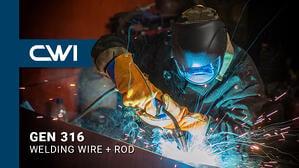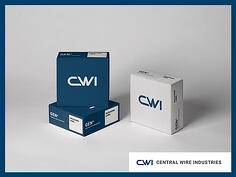For every welding application, there is a CWI Generation4™ welding consumable that meets your requirements. From a tank overlay in chemical processing to automotive repair or pipe fabrication, we offer a wide range of high-quality alloys that fulfill the specific consumable needs of submerged arc welding (SAW), tungsten inert gas welding (TIG) and gas metal arc welding (GMAW). To achieve the highest quality welds possible, using our evolutionary Generation4™ products, consider three things: welding type, alloys, and packaging.
 Welding Type
Welding Type
The first step to determine which type of welding wire you need is to consider your welding type. MIG, TIG, and SAW applications each require different types of wire. Your welding type will determine whether you use welding wire in rods or spools. Each welding type also uses different diameters of welding wire. If you need assistance, refer to page six in our welding wire catalog for a chart that provides wire diameters by welding type. If the diameter of your wire is too large, you will lose precision, clean-up will be excessive, and tip blockage may occur. If the diameter is too small, it may not fully penetrate the material, and the tip may fuse to the wire due to arcing. Both will cause quality control issues and cost you time and money.

Alloys
Before selecting a welding wire alloy, take note of your base material and environment. If your project will experience extreme heat or chemical exposure, you may want to consider a corrosion-resistant alloy. Your welding wire and base metal must also be compatible. For example, if you use 316 stainless steel as a base metal, you would use Gen 316L as your welding wire. CWI offers a broad selection of welding wire alloys, including stainless steel and nickel. Whether you need corrosion resistance, strength, or ductility we have a welding consumable that will meet your needs. To learn all about the chemical composition of our alloys, visit https://centralwire.com/alloys/ or browse our welding wire webpage.

Packaging
Choosing the correct packaging for your welding wire is important because it affects the time spent on changeover. You don't want your packaging sitting out for too long with the risk of it coming in contact with moisture or contaminants, and you don't want packaging that you are changing over often because the size is too small for the job. From reels and spools to drums and tubes, CWI offers a variety of packaging options to suit your needs. If you are working with smaller quantities of material, we offer 2lb. and 10lb. spool options for MIG wire as an alternative to the standard 33lb spools. If you are working with large quantities of material, reels or packs may be a better solution for your operation. To learn about our options, refer to page 7 of our welding wire catalog or visit https://centralwire.com/products/welding-wire/.
Learn all about our full line of Generation4™ welding wire consumables at https://centralwire.com/products/welding-wire/.